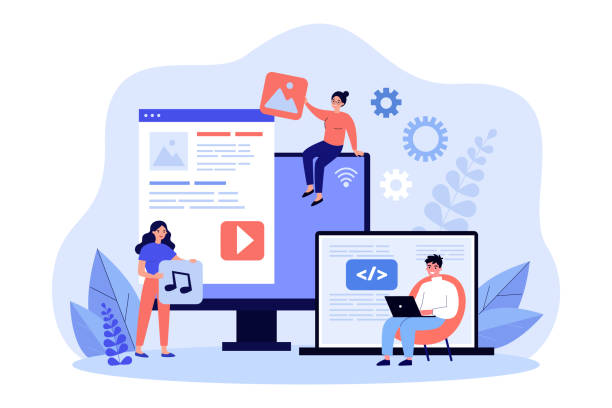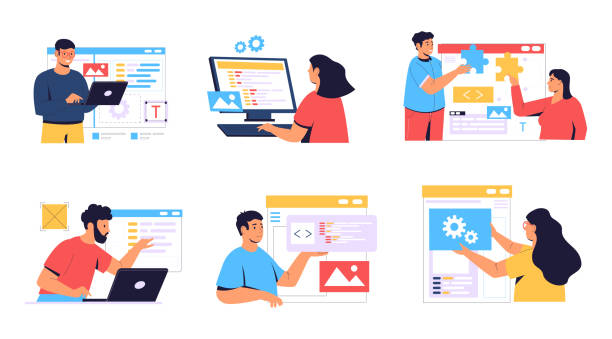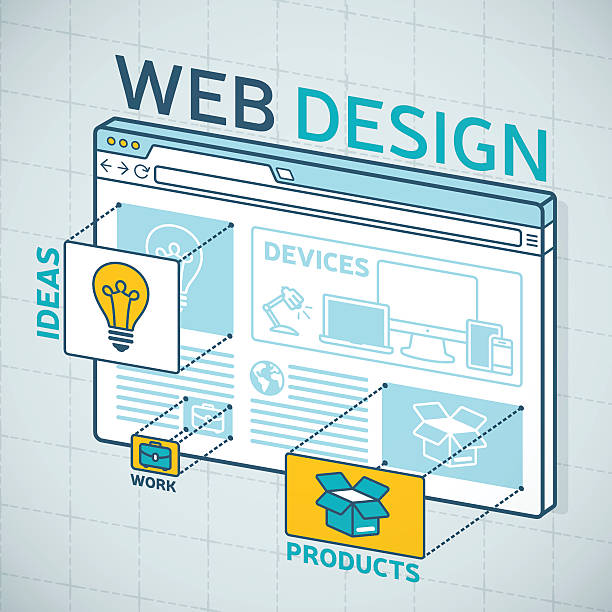1. Why is Responsive Website Design More Important Today Than Ever Before?

In today’s world, where users access the internet from a variety of devices, from smartphones and tablets to laptops and large monitors, having a website that displays correctly on all these platforms is not a privilege but a necessity.
#Responsive_Design or #Responsive_Website_Design, is the answer to this pressing need.
This approach ensures that your website intelligently adapts itself to the screen size and orientation without the need to develop separate versions for each device.
This adaptability not only significantly improves the user experience (UX) but also plays a vital role in search engine optimization (#SEO), as search engines like Google rank responsive websites higher.
Understanding the principles of responsive website design is the first step towards building a successful and future-oriented online presence.
Did you know that 94% of a first impression of a company is related to its website design?
RasaWeb, by providing professional corporate website design services, helps you create the best first impression.
✅ Create a professional and trustworthy image for your brand
✅ Easier attraction of potential customers and improved online standing
⚡ Get free corporate website design consultation
2. Fundamental Principles of Responsive Design: Fluid Grids, Flexible Images, and Media Queries

The main concept behind responsive design rests on three pillars: Fluid Grids, Flexible Images, and Media Queries.
Fluid Grids mean that your website layout is defined by percentages instead of fixed pixel dimensions.
This allows page elements to float and resize proportionally to the available space.
Flexible Images, using CSS and setting their width as a percentage (e.g., 100%), ensure that images never exceed their parent container and scale appropriately with the page size.
The third pillar, Media Queries, performs the main magic; this CSS3 capability allows you to apply different styles based on device characteristics (such as screen width, height, orientation, and resolution).
For example, for smaller screens, you can change font sizes or move some columns below each other.
This intelligent combination forms the foundation for correctly implementing a responsive website design and is an essential and #educational knowledge for every web developer.
3. Competitive Advantages and SEO Optimization with Responsive Design

Choosing the responsive website design approach brings significant benefits for businesses and websites.
The first and most important advantage is improved user experience.
Users, regardless of the device they use, encounter a consistent and optimized user interface, leading to increased satisfaction and reduced bounce rates.
Secondly, from an SEO perspective, Google and other search engines prefer responsive websites.
Having a single URL for all devices simplifies the crawling and indexing process for search engines and prevents duplicate content issues.
This significantly helps improve the website’s ranking in search results.
Thirdly, managing and maintaining a single website is significantly simpler and more cost-effective than developing and maintaining multiple separate versions.
Finally, faster loading speeds and better performance on mobile devices, which are key SEO ranking factors, are other important achievements of this approach.
All of these demonstrate why a website with responsive design is a smart and #analytical investment for the digital future.
Table 1: Common Breakpoints in Responsive Design
| Screen Size (pixels) | Typical Device Type | Description |
|---|---|---|
| Up to 575px | Small Mobiles | Single-column layout, larger font size for readability |
| 576px – 767px | Large Mobiles and Vertical Tablets | Reduced margins, two columns for some sections |
| 768px – 991px | Horizontal Tablets and Small Laptops | Standard layout, four or more columns |
| 992px – 1199px | Laptops and Medium Desktops | Full layout, more complex navigation |
| 1200px and above | Large Desktops and Wide Monitors | Maximized layout, utilization of full screen space |
4. Technical Aspects of Responsive Design: CSS, HTML, and JavaScript

Implementing a responsive website design requires a deep understanding of how CSS, HTML, and JavaScript work together.
In the CSS section, features like Flexbox and Grid Layout have become powerful tools for creating complex and flexible layouts.
Flexbox is ideal for one-dimensional layouts (row or column), and Grid Layout for two-dimensional layouts (row and column), serving as modern and more efficient alternatives to older methods like float or table layout.
In HTML, the use of semantic elements and optimizing the DOM structure is crucial to ensure accessibility and proper performance across different devices.
Also, using the `srcset` and `sizes` attributes for the `img` tag allows the browser to load the most appropriate image size for the user’s device, which helps improve loading speed.
In JavaScript, care must be taken that scripts do not disrupt website performance on small devices.
Conditional Loading or using lightweight and optimized scripts for mobile are important points in this regard.
This is a #specialized discussion that requires deep knowledge in these areas.
Are you disappointed with the low conversion rate of your online store?
RasaWeb, with its professional e-commerce website design, is your definitive solution!
✅ Increase your sales and revenue
✅ Unparalleled user experience for your customers
⚡ Get free consultation now!
5. Mobile-First Design Philosophy: Content Priority in Responsive Design

The “Mobile-First” approach is one of the most important philosophies of responsive website design.
This means that the website design and development process begins with the smallest screen (typically mobile) and then gradually expands to larger screens (tablet, desktop).
The reason for this approach is that designing for constraints (small screen, less bandwidth, touch interaction) is much more challenging.
By starting with mobile, designers and developers are forced to identify and prioritize essential content and core website functionality.
This leads to the elimination of unnecessary elements and improved user experience on mobile devices.
Also, touchable elements and navigation must be designed to be easy to use with fingers.
Considerations include designing larger buttons, sufficient spacing between links, and dropdown or hamburger menus for mobile.
This is a key #guidance for anyone looking to create a modern and user-friendly website.
6. Tools and Methods for Testing Responsive Design

After implementing responsive website design, the critical step is testing and ensuring its correct performance across different devices and browsers.
Browser developer tools (such as Chrome DevTools) provide the ability to simulate various devices with different sizes and resolutions, allowing for quick and initial testing.
These tools also allow changing the User Agent and testing touch modes.
Additionally, online tools like Responsinator, Am I Responsive, and BrowserStack (for real testing on physical browsers and devices) help you test your website in diverse environments.
Automated tests can also be part of the development process to ensure that new changes do not break responsiveness.
The important point is that testing is not limited to screen sizes, but should also include testing loading speed, touch usability, and behavior under different network conditions.
This is an important #explanatory section in the website development lifecycle.
7. Challenges and Best Practices in Responsive Design

Although responsive website design offers countless advantages, its implementation is not without challenges.
One of the biggest challenges is performance management.
Loading large images or heavy scripts can slow down the website on mobile devices.
To overcome this problem, using techniques such as lazy loading images, code compression, and font optimization is essential.
Another challenge is the complexity of specific layouts; sometimes converting a complex desktop layout into a simpler mobile version requires creativity and careful planning.
Best practices include using CSS frameworks like Bootstrap or Tailwind CSS, which provide ready-made tools for responsive design.
Also, focusing on content and visual hierarchy, designing for touch interaction, and smart use of media queries to fine-tune the user experience at each breakpoint are key points.
This #thought_provoking_content and #analytical section helps you overcome potential obstacles.
Table 2: Best Practices in Responsive Design
| Principle | Explanation | Implementation Example |
|---|---|---|
| Mobile-First | Start design and development from the smallest screen. | Define base styles for mobile, then expand with media queries. |
| Fluid Images | Images should scale with screen size and prevent overflow. | max-width: 100%; height: auto; in CSS. |
| Responsive Typography | Font sizes and line heights should adapt to the screen size. | Use relative units like em, rem, vw. |
| Performance Optimization | Ensure high loading speed on all devices. | Image compression, Lazy Loading, caching, CSS/JS optimization. |
| Touch Usability | Clickable and interactive elements should be suitable for touch. | Sufficient space between buttons, large buttons (minimum 48x48px). |
8. Beyond Responsive Design: New Approaches and the Future of the Web

While responsive website design remains the golden standard, the web world is rapidly evolving, and new approaches are emerging that complement or even replace it.
Adaptive Design is one such approach that, instead of continuous adjustment, creates several fixed layouts for specific screen sizes.
The website then presents the most suitable layout depending on the user’s device.
On the other hand, recent advancements in Progressive Web Applications (PWA) and modern JavaScript frameworks like React, Vue, and Angular, have made it possible to build highly dynamic and app-like user experiences that work well on any device.
Also, the concept of “Content-out” as opposed to “Canvas-in” means that design should start from the content and then determine how it is displayed across different dimensions.
Artificial intelligence could also play a significant role in the future in automating responsive design and optimization processes.
These are #news and progressive aspects in the web domain that shape the future of responsive website design.
Does your current website build the trust that potential customers should have in your business? If the answer is no, it’s time to have your professional and impactful corporate website with RasaWeb.
✅ Fully custom design tailored to your brand identity
✅ Increased lead generation and business credibility in the eyes of customers⚡ Contact us for a free consultation!
9. Implementation Strategies: Choosing Frameworks and Content Management Systems

For implementing responsive website design, there are various options, each with its own advantages and challenges.
One of the most common approaches is using CSS frameworks like Bootstrap, Foundation, or Tailwind CSS.
These frameworks, by providing a set of ready-made classes and components, accelerate the responsive design process and simplify ensuring compatibility across different browsers.
Another option is building the website from scratch (Custom Build), which provides complete control over the code and specific project optimizations, but is more time-consuming.
For many businesses, using Content Management Systems (CMS) like WordPress, Joomla, or Drupal, along with responsive themes, is a fast and efficient solution.
These CMSs, with their plugins and themes, enable the creation of responsive websites without the need for deep programming knowledge.
The choice of strategy depends on budget, timeline, and project complexity.
This is #practical_guidance for developers and website administrators.
10. Responsive Design: An Investment for Your Digital Future

Ultimately, responsive website design is no longer a luxury option, but a vital requirement for any online entity.
This approach not only significantly improves user experience and makes your website accessible on all devices, but it is also essential for search engine optimization and thus increasing your business’s visibility.
In an era where more than half of web traffic comes from mobile devices, ignoring responsive design means losing a large portion of your audience and business opportunities.
This is a long-term investment that helps you stay one step ahead in the competitive digital landscape and prepare your website for future changes.
Remember, a website that adapts to user needs and technological changes will always be more successful.
Therefore, attention to responsive website design is the key to success in today’s and tomorrow’s online world.
This is an #explanatory summary of the importance of the topic.
Frequently Asked Questions
| Question | Answer |
|---|---|
| What is responsive website design? | Responsive Web Design is an approach where the design and layout of a website automatically adjust to the screen size and user’s device (such as desktop, tablet, mobile) to provide the best user experience. |
| Why is responsive website design important? | With the increasing use of mobile devices and tablets for browsing the internet, responsive design ensures that your website displays well at any size, and users do not need to zoom or scroll horizontally, which leads to improved user experience and reduced bounce rate. |
| What are the main techniques used in responsive design? | The three main techniques include Flexible Grids, Flexible Images, and Media Queries in CSS. |
| What is a Media Query? | A Media Query is a capability in CSS that allows you to apply different styles based on the user’s device characteristics such as screen width, height, orientation (portrait or landscape), and resolution. |
| What impact does responsive design have on SEO? | Google prefers responsive websites and ranks them higher in mobile search results. Also, an improved user experience leads to a lower bounce rate and an increased duration of user presence on the site, which are positive signals for search engines. |
And other services of Rasa Web Advertising Agency in the field of advertising
Smart Social Media: A new service for increasing digital branding through the use of real data.
Smart Direct Marketing: A specialized service for campaign management growth based on intelligent data analysis.
Smart Custom Software: An effective tool for online growth using real data.
Smart Link Building: Professional optimization for customer acquisition by optimizing key pages.
Smart Sponsored Content: A combination of creativity and technology to increase website visits through intelligent data analysis.
And over hundreds of other services in the field of internet advertising, advertising consultation, and organizational solutions
Internet Advertising | Advertising Strategy | Advertorials
Sources
What is Responsive Design?Responsive Web Design – WikipediaWhat is Responsive Web Design and Why is it Important?Responsive Design Tutorial
? For a big leap in your business and to reach the pinnacle of success, RasaWeb Afarin Digital Marketing Agency is by your side with its specialized services. Have a powerful online presence right now with fast and professional website design.
📍 Tehran, Mirdamad Street, next to Central Bank, Southern Kazeroun Alley, Ramin Alley, No. 6




